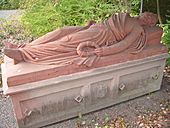Wilhelm Hornberger

Wilhelm Hornberger (born February 21, 1819 in Ilbesheim near Landau , † June 20, 1882 in Weinheim ) was a German sculptor of late classicism and historicism .
Live and act
Wilhelm Hornberger was the son of a winemaker from Ilbesheim and attended the Latin school in Landau (Palatinate) from 1832 to 1836 . The artist Johann Gottfried Gerhardt (1772–1838) was his drawing teacher there. He recognized and promoted his talent. From 1836 Wilhelm Hornberger worked in the workshop of the sculptor priest Bernhard Würschmitt in Bad Bergzabern and trained as a stone mason or sculptor. Konrad Knoll also learned here later .
In 1839 Hornberger went to Munich and attended the Academy of Fine Arts . There he became a favorite student of Ludwig Schwanthaler ; study trips to Italy and Greece also took place.
Hornberger settled in Mannheim in 1847 , where the widowed Grand Duchess Stefanie set up a spacious studio for him in the palace . One of his first larger works was the tomb of the Landau fortress commander Georg von Mölter , who died in 1846, and which has been preserved in the Landau cemetery.
Hornberger created a similar, even more qualitative tomb in 1852 for Mölter's successor Karl von Pflimmern . This, too, has been preserved in the Landau cemetery and, like the former, is protected against weathering with a modern protective roof. King Ludwig I visited it in advance in 1852 and expressed his respect for the work of the artist.
In 1866, Wilhelm Hornberger was also commissioned to create a memorial for Goethe's lover Friederike Brion (1752–1813), whose grave in Meißenheim was then rebuilt. Hugo Oelbermann was one of the fundraisers . Since the grave is one of the Goethe memorials, this memorial stone is probably the most famous work of the sculptor today. A guaranteed portrait of Brion was not available when the stone was made, which is why Hornberger designed the picture medallion after her sister's great-granddaughter, who was then living.

Despite the high artistic quality of Wilhelm Hornberger's work, there were no significant commissions and the sculptor lived mainly from the production of tombstones in the vicinity, as well as from smaller, occasional commissions. For example, he made a monument to King Wilhelm II for the Dutch city of Arnhem in 1865 .
Hornberger died in Weinheim in 1882.
literature
- Herrmann Julius Meyer: New Konversations-Lexikon , 1865, Volume 9, Page 98; Scan from the source
- Viktor Carl: Lexicon of Palatinate personalities . Hennig Verlag, Edenkoben, 2004, ISBN 3-9804668-5-X , page 386
- Friedrich Müller: The artists of all times and peoples , Volume 4, Page 209, Stuttgart, 1870; Scan from the source
- Monika Bürger: Mannheim Baroque Palace: History and furnishings: Krone der Kurpfalz , 2007, ISBN 3-86568-183-2 , page 165; Excerpt from the source
Web links
Individual evidence
- ^ Entry on Johann Gottfried Gerhardt in the catalog of the German National Library
- ^ Registration of the Academy of Fine Arts in Munich, 1839
- ↑ Joseph Meyer: The great conversation lexicon for the educated classes , 3rd supplement volume, 1853, page 1492
- ↑ PDF document on the grave of Friederike Brion in Meißenheim
- ↑ Website on the monument in Arnhem, with a mention of Hornberger and a photo of the statue
| personal data | |
|---|---|
| SURNAME | Hornberger, Wilhelm |
| BRIEF DESCRIPTION | German sculptor and stonemason |
| DATE OF BIRTH | February 21, 1819 |
| PLACE OF BIRTH | Ilbesheim near Landau in the Palatinate |
| DATE OF DEATH | June 20, 1882 |
| Place of death | Weinheim |


